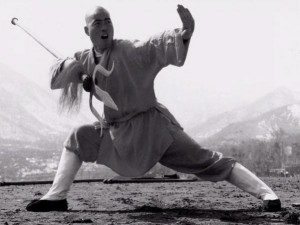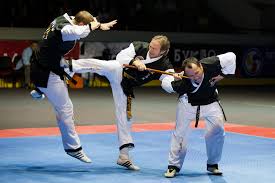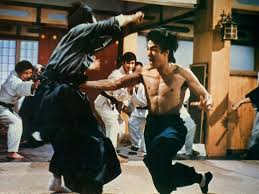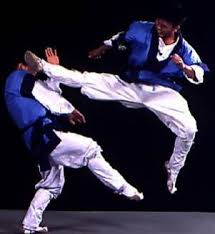Wing Chun
 Wing Chun is a Wushu school in China that uses a wide variety of combat techniques and is therefore defined as the applied direction of Wushu. The battle in Wing Chun is based on certain principles comprehended by a student during training. Departures from the attack line are combined with fast linear attacks when approaching a very close range. Often a fight ends with knees and elbows. A special exercise “sticky hands” helps the fighter to navigate well during a fight at close distances. As part of the style, there are also techniques using a knife that are associated with the technique of fighting hands and fighting techniques without using weapons. Also, with the sticky hands technique, students are trained in throws and grabs.
Wing Chun is a Wushu school in China that uses a wide variety of combat techniques and is therefore defined as the applied direction of Wushu. The battle in Wing Chun is based on certain principles comprehended by a student during training. Departures from the attack line are combined with fast linear attacks when approaching a very close range. Often a fight ends with knees and elbows. A special exercise “sticky hands” helps the fighter to navigate well during a fight at close distances. As part of the style, there are also techniques using a knife that are associated with the technique of fighting hands and fighting techniques without using weapons. Also, with the sticky hands technique, students are trained in throws and grabs.
The history of style in legends
Wing Chun Usually the origin of Wing Chun is historically tied to the South Shaolin Monastery. One legend says that the style was created by the rector of Southern Shaolin Zhishan to conduct wellness exercises that could be done by residents of nearby villages. According to the second legend, the style was formed by 5 South Shaolin masters in the Wenchuntang Spring Hall of Praise. According to the third legend, the style was created by the woman Yan Yunchun – Eternal Spring, who was the daughter of the novice of the Southern Shaolin Yan Era. She created the teaching either on the basis of skills received from her father, or based on the technique of the nun Umei.
In the 1930s and 1940s, a renowned Chinese expert on Wushu history, Tang Hao, conducted field research and determined that the monastery called “Southern Shaolin” did not exist in nature at all. This monastery was invented in the “knightly” novel of the medieval era “Wan Nyan Qing”, which tells how the Chinese emperor seemed to have traveled unrecognized through the territory of Southern China, while falling into all sorts of stories. And Zhishan, Umei, and others are just the characters in the novel. The overwhelming majority of people in China did not know how to read and write – therefore, the content of books for a fee was told in the markets. Ordinary people could not distinguish works of art from real events, and imagine that some geographical names of places, objects are located at great distances from each other, that the people mentioned in the stories did not exist – listeners of stories on the market could not do it.
The history of this style, similar to the truth, can be traced only from the end of the 18th century – this is the time when this Wing-chun got into the Guangdong opera “Red Junka”. Wing-chun traveled with the actors of the opera – people from them adopted this style in various parts of China. Wing-chun was used both by revolutionaries of China, and by self-defense units of villages. In the middle of the 19th century, two actors of a wandering troupe left her and began to live in Foshan, where they taught the art of combat to pharmacist Liang Zhan. This man became famous as the “King of the Winchun”, having won in many battles. He did not have an official school; he conducted training in a pharmacy privately. Later, Liang Zan left his job and returned to his village of Gulao, in which he was engaged in training rural residents.
From Foshan the official history of the main direction of Wing Chun began. The children of wealthy merchants taught this style in Foshan because their parents were able to pay the high cost of training, and children from these families could devote a lot of time to training. One of the most popular students – Ye Wen – studied style with teachers Chen Huashun, Liang Bi and Wu Junsu. Ye Wen moved to Hong Kong since 1949, where he taught the style of restaurant workers union members. Until the end of his life in 1973, he managed to train a large number of nowadays popular masters. Ye Wen glorified Wing-chun, but did not always use the right methods for this. Often his students came to other martial arts clubs in Hong Kong and beat the masters who taught there. Nowadays, many Wincun clubs are open in Hong Kong, mainly Yip Man’s students are teaching there.
The Vietnamese branch of Wing Chun begins in 1939 from the famous Chinese master Ruan Jiyun, who came to Hanoi at the special invitation of the Association of Chinese Emigrants in Vietnam. This master has implemented the principle of Chinese martial arts, which says: “four lan to overcome a thousand jing”, which means: “a weak effort extinguishes the attack.”
Famous Style Options
All styles are translated as “Fist of praise of spring” or “Fist of eternal spring,” the code is added as the ending name of the person or area from where a particular version of the style originated. So, at the moment, one can distinguish style options – Fist of Eternal Spring by E Wen, Yip Man, Fujian Province, Fist of praising the spring of the hands of Buddha, Gulao Village, Red Junka of the Hu and Huang families, Tszyu Wan, Li Shin, Liang Guangman, Peng Nan, Liu Dasheng, Ruan Qishan, Foshan city, as well as Malay, Vietnamese and a variant of the countries of Southeast Asia.




